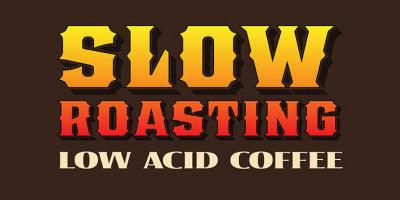
Slow Roasting Low Acid Coffee
Slow Roasting Low Acid Coffee
There are several techniques that can be used to affect the level of acidity in coffee. Some approaches use pre-treatments, interrupted roasts, and applying additives. However, since we are a 100% organic coffee roaster, most of these processes do not meet our standards.
Additionally, none of these processes are truly as effective at lowering the levels of Chlorogenic acid as slow roasting coffee is. Moreover, slow roasting coffee provides a natural, more balanced, and smooth cup. It also dramatically reduces the acid levels in coffee.
So how do we do it? Coffee roasting concerns itself with three basic elements: time, temperature, and airflow. These elements are the core of any coffee profile. You cannot roast coffee without time, temperature, and airflow. Slow roasting requires a very precise and detailed attention to these three elements. The first one we will discuss is heat and heat transfer (temperature).
Managing Heat in a Low Acid Roast
In roasting coffee, heat is delivered to the coffee beans in two ways. The first way to distribute heat is through conduction. The coffee beans come in contact with the drum inside the coffee roaster chamber and the heat produced by the gas fired burner is transferred from the surface of the roaster drum to the surface of the coffee bean. The process of transferring heat by contact is called conduction.
The second way to transfer heat is through convection. The coffee beans come in contact with hot air inside the coffee drum chamber that is generated from the heat produced by the gas fired burner and a fan that moves that heat around in the drum chamber. Convective heat not only impacts the surface of the bean, but also penetrates the beans cellular structure. The process of heat transfer by air is called convection.
Conduction and convection are two elements of heat transfer that coffee roasters have to manage when roasting coffee on a traditional drum roaster. For the roaster, managing these types of heat transfer can be very difficult. While both conduction and convection are a process of transferring heat, the efficiency of heat transfer is very different. If you have ever cooked a turkey in a traditional oven (conduction) and then cooked the same turkey in a convection oven, you would notice that the convection oven cooks the turkey faster.
Convective heat is more efficient and can actually penetrate the surface. In the case of the coffee bean, convective heat can begin to roast the coffee bean from the inside out, while the conductive heat roasts the coffee from the outside to the inside.
This means that a coffee roaster must manage both his convective heat and conductive heat in a controlled fashion to yield a uniform and consistent roast of the coffee beans, despite the different levels of efficiency between them. If either method of heat transfer in the roast is outside of their proper proportion, the roast can be affected in a numbers of ways and lead to an under-developed or an over-developed coffee bean, which can significantly and negatively affect taste.
Secondary Heat in a Slow Roast
To add an additional wrinkle, the roaster must account for other factors beyond just managing the coffee roaster's burner control, which produces the heat, and the roaster's exhaust fan, which distributes the heat around the drum chamber. The roaster must also account for the radiant heat from the other coffee beans, which first absorb heat, which is in an endothermic activity, and at certain times release heat, which is an exothermic activity. This shift in thermal mass could significantly affect the trajectory of the roast and completely knock the coffee off the desired roast profile.
During the roast, the coffee beans can also act as a kind of secondary source of conductive and convective heat. First, as the coffee beans contact each other in the drum chamber, heat is transferred conductively from bean to bean. Secondly, and most notably, during the exothermic periods of the roast, when the coffee beans release heat, the beans will increase the overall temperature of heat in the drum chamber and possibly push the roast outside the parameters of the profile.
Slow Roasting Takes Time:
It might sound obvious, but slow roasting takes time, and lots of it. Compared against modern profiles, slow roasting can take two or three times longer than conventional roasts.
Time is a vital component to the roast and it is no less critical to the roasting process than temperature or the airflow. However, time is not just to measure the beginning and ending of the roast, but also it maps out and sets the groundwork for the entire roast.
A slow roast profile is very time sensitive. Most milestones achieved during the roast are often associated with heat because they happen at approximate temperatures, but the time those milestones occur and the duration of those events must also be precisely accounted for in any slow roast profile. In fact, when we slow roast we manually record well over 100 data points based on a time basis of every 15 seconds.
In short, reducing Chlorogenic acid not only takes heat, but it also takes time. Achieving a certain temperature is not enough to reduce Chrologenic acid. It is sustaining that heat for the required duration that makes coffee low in acid.
-Mavericks